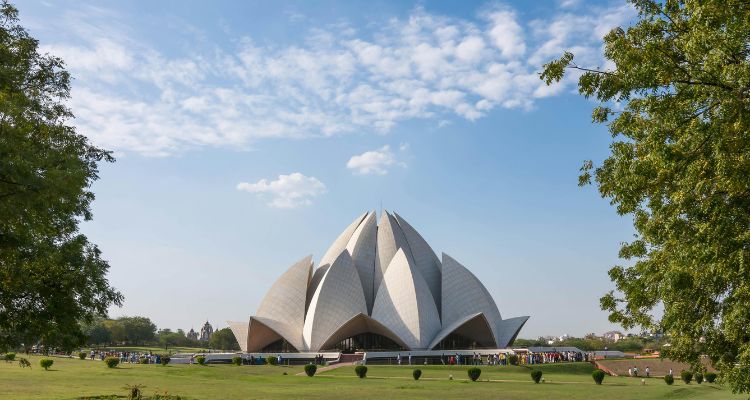
While Delhi is known for its bustling markets and iconic landmarks, the city also hides a wealth of lesser-known treasures that offer unique and enriching experiences. Start Delhi sightseeing tour with the Jama Masjid, one of the largest mosques in India, often overshadowed by nearby markets—climb its minaret for a stunning panoramic view of Old Delhi. Not far away, the serene Purana Qila (Old Fort) invites you to walk through centuries of history surrounded by peaceful gardens and ancient ruins. In Mehrauli, the Alai Darwaza, a 14th-century gateway with stunning Islamic calligraphy and red sandstone architecture, sits quietly next to the more famous Qutub Minar, waiting to be admired.
Continue your offbeat trail at Feroz Shah Kotla Fort, where mystical legends mix with medieval ruins and an ancient Ashokan pillar. For a change of pace, the National Rail Museum offers a fascinating peek into India’s railway history, complete with vintage trains and interactive exhibits. Seek calm at Safdarjung Tomb, a beautiful yet less-visited Mughal-era mausoleum with symmetrical gardens and grand domes. End your journey at the peaceful Lotus Temple, a modern architectural marvel that welcomes people of all faiths into its serene, flower-shaped sanctuary. These seven spots offer a quieter, deeper look into Delhi’s diverse heritage, away from the typical tourist path.
1. Jama Masjid
Dominating the skyline of Old Delhi, Jama Masjid is one of India’s largest and most magnificent mosques. Built by Mughal emperor Shah Jahan in the 17th century, it features grand red sandstone steps, towering minarets, and a vast courtyard that can hold over 25,000 worshippers. The mosque’s intricate carvings and serene ambiance offer a glimpse into the architectural brilliance and spiritual soul of Mughal-era Delhi. Climb the southern minaret for breathtaking views of the bustling streets below and the timeless charm of the old city.
2. Purana Qila
One of the oldest forts in Delhi, Purana Qila (Old Fort) stands as a silent witness to the city’s ancient past, believed to be built on the legendary site of Indraprastha from the Mahabharata. Originally constructed by Humayun and later renovated by Sher Shah Suri, the fort showcases impressive Mughal architecture with massive gateways, thick ramparts, and a tranquil moat. A walk through its grand gateways and quiet pathways transports visitors to a bygone era, making it a must-visit for history lovers seeking a peaceful escape in the heart of the capital.
3. Alai Darwaza
Located within the Qutub Complex, Alai Darwaza is a striking 14th-century gateway built by Alauddin Khilji in 1311. It is celebrated as one of the earliest examples of true Indo-Islamic architecture in India, blending intricate red sandstone carvings with elegant Islamic arches and domes. Though often overshadowed by the towering Qutub Minar nearby, Alai Darwaza’s detailed lattice work and symmetry offer a unique glimpse into Delhi’s architectural evolution and the artistic finesse of the Delhi Sultanate era.
4. Feroz Shah Kotla fort
Built in the 14th century by Sultan Feroz Shah Tughlaq, Feroz Shah Kotla Fort is a hauntingly beautiful ruin that offers a glimpse into Delhi’s medieval past. Once a grand citadel along the Yamuna River, the fort is now known for its atmospheric remnants—crumbling walls, secret chambers, and a 13-meter-high Ashokan pillar that predates the fort itself. Today, it draws not just history enthusiasts but also locals who come to leave letters and light candles, believing the ruins are inhabited by spirits. Mysterious yet captivating, it’s one of Delhi’s most intriguing, offbeat attractions.
5. National Rail Museum
A delight for both kids and adults, the National Rail Museum in Delhi offers a fascinating look into the rich history of Indian railways. Spread across 11 acres, the museum features vintage locomotives, royal saloons, and rare steam engines, including the Fairy Queen, the world’s oldest working steam engine. Interactive exhibits, toy train rides, and well-preserved carriages make it an engaging and educational experience, offering a nostalgic journey through the tracks of India’s past.
6. Safdarjung Tomb
Tucked away in the heart of Delhi, Safdarjung Tomb is a stunning yet often overlooked example of late Mughal architecture. Built in 1754 for Nawab Safdarjung, the tomb is set amidst lush gardens and features a grand sandstone and marble facade with elegant domes and intricate detailing. Though it marks the fading glory of the Mughal era, its peaceful atmosphere and symmetrical beauty make it a perfect retreat for travelers looking to explore Delhi’s quieter, more soulful heritage sites.
7. Lotus Temple

The Lotus Temple in Delhi is a breathtaking architectural marvel, shaped like a giant white lotus flower and surrounded by tranquil gardens and reflecting pools. Open to people of all religions, this Bahá’í House of Worship offers a peaceful space for meditation and silence, free from rituals or sermons. Its elegant design and spiritual openness make it one of the most visited and admired landmarks in the city, offering both serenity and inspiration in the heart of bustling Delhi.